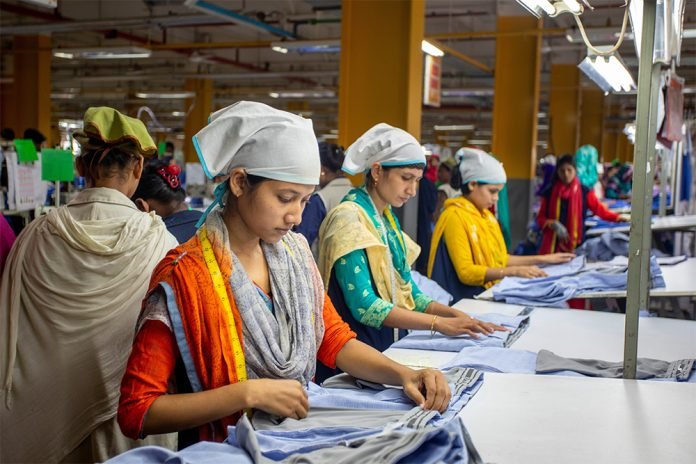Bangladesh government has decided to gradually withdraw all cash incentives to export sectors (mainly readymade garments) by July 2026 at a rate of o.5 percent every six months, before the country’s scheduled graduation from Least Developed Country status.
The program is already in force from January this year with initial cuts in cash stimulus, other export sectors will have export incentives slashed by a third every year before being phased out by July 2026.
The export sectors however, will be compensated by alternative supports in the forms of electricity tariff waivers by up to 10 percent, exemption of licensing fees and import of capital machinery and spare parts paying at a maximum 1 percent duty. Export industries will be offered low-interest loans and tax breaks for green energy and effluent treatment plants, according to the commerce ministry’s policy draft.
Being the largest export sector, the RMG enjoys the most of the cash benefits that led to its spectacular rise in the last four decades and now stands to lose the most as the Bangladesh Bank already started to implement the roadmap in January. Currently, 43 sectors enjoy incentives, most of which come as cash assistance, which almost all exporters of readymade garments enjoy. For them, the rate was 4 percent, which was reduced to 3 percent, as per the 30 January circular of the central bank. In the first instance in January, it completely withdrew the 1 percent special cash incentive against exports of five HS-coded goods in the readymade garments sector. Later, 0.50% was reinstated under the directive of the Prime Minister following demand from the industry.
Apparel industry leaders are concerned about an adverse effect of withdrawal of cash incentives, saying the government needs to put substitutes in force to support export sector stay afloat and competitive after LDC graduation when duty-free access will end. Industry analysts say the phase-out of cash support is unavoidable under the WTO rule after LDC graduation and businesses need to be ready for the reality with alternative policy supports from the government.
The budget for the current fiscal year has an allocation of Tk15,225 crore in export and remittance incentives. The government’s actual expenditure on this in FY 2021-22 was Tk13409 crore. Of the allocation, remittance incentives amount to about Tk4000 crores. Exporters get the rest. And out of this, readymade garment exporters get about 70 percent. In view of LDC graduation, the government had to start reducing cash incentives against existing exports in various sectors from the second half of the current financial year.
There are other incentives in the readymade clothing sector. For example, in addition to the existing 3 percent special support for exporters in the Eurozone, there is 1 percent special support. Small and medium industries in the readymade garment sector get an additional 4 percent cash support. Besides, the government is providing additional 3 percent cash assistance for export of new products and export to new markets, and manmade fiver products. The rate of these incentives will also be reduced by the Ministry of Finance every six months.
At present, some of the incentives in the export sector include duty drawback scheme, interest rate subsidy, special bonded warehouse, back to back letter of credit, export processing zone (EPZ) facility, import of machinery for export oriented industries, cash incentive, income tax rebate, currency retention scheme, export credit, guarantee scheme, Export Development Fund, exemption of VAT on exports, refund of VAT to exporters are notable.
Commerce Ministry officials said that export incentives, income tax concessions and currency retention schemes cannot be given if promoted to developing countries. However, duty drawback, VAT exemption on import and export of inputs used in the production of export goods, VAT refund to exporters, EPZ facility, back to back LC facility, special bonded warehouse and duty drawback scheme facility can be continued.
Besides, the export credit guarantee scheme will not be feasible unless the long-term operating costs are factored in. Moreover, the rate of interest and the rate of interest in providing export development funds cannot be lower than the interest rate of the international capital market.
As an alternative to cash incentives, there will be concessions of 5 percent to 10 percent on electricity bills of industries producing major export products, waiving of all types of licensing fees for exporting companies and maintaining the maximum duty rate of 1 percent on the import of capital machinery and spare parts.
Low interest bank loans will be provided from the Export Development Fund for setting up green energy units in export-oriented industries that require round-the-clock electricity. For setting up effluent treatment plants and eco-friendly factories, this fund will provide subsidised interest or low interest loan assistance from the government.
According to the calculations of the General Economics Department of the Planning Commission, the loss of duty-free benefits due to LDC graduation could reduce Bangladesh’s export earnings by seven billion dollars.
However, the European Union and the United Kingdom will continue the duty-free benefits for three years even after LDC graduation. This means, even after graduation, 60 percent of Bangladesh’s total exports will not suffer at all until at least 2029.
About 73 percent of Bangladesh’s total exports enjoy duty-free facilities. And 80 percent of this is exported to the EU and UK. The remaining 20 percent duty-free export facility is likely to be lost after the LDC graduation.
Apparel industry players think Cash incentives can be continued till graduation so that exporters can achieve competitiveness by 2026.” They regret that the Ministry of Finance has not discussed with the exporters about the roadmap for withdrawal of cash incentives.
They pointed out that India offers 50 percent of workers’ wage as support for textile industries set up in six of its states. Besides, 30 percent of the interest waiver and 2 rupees discount per unit on electricity bill are among the offers for the apparel sector in the neighbouring country.



